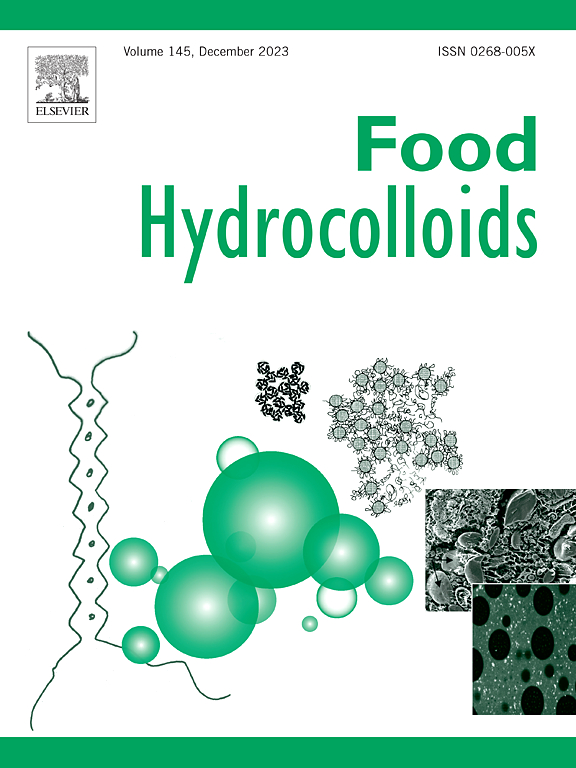Electrokinetic interaction and dynamic wetting behavior of soy protein/gum arabic coacervates as soft particles
IF 11
1区 农林科学
Q1 CHEMISTRY, APPLIED
引用次数: 0
Abstract
In recent years, the growing demand for sustainable and clean-label health foods has made mild processing a key approach to obtaining less denatured and high-quality plant-based protein ingredients. This study compared soy protein isolate (SPI) obtained via salt extraction (S-SPI) with SPI obtained via the conventional alkali-solubilization and acid-precipitation method (A-SPI), to investigate the impact of protein aggregation structure on the formation of SPI/gum arabic (GA) complex coacervation. Native-PAGE and SDS-PAGE results revealed that mild extraction processes lead to the enrichment of glycinin in SPI. The electrokinetic interactions of S-SPI/GA coacervates were analyzed using soft particle theory, linking the charged properties of biopolymers to their complex structures. Dynamic wetting behavior results showed that the low interfacial tension of S-SPI/GA coacervates facilitated wetting at the oil–water interface and the formation of a continuous layer. This study proposed a novel approach to developing low-denaturation, natural plant proteins and provided new insights into the formation mechanisms of plant protein-based complex coacervates.

大豆蛋白/阿拉伯胶作为软颗粒凝聚的电动力学相互作用和动态润湿行为
近年来,对可持续和清洁标签健康食品的需求不断增长,使得温和加工成为获得较少变性和高质量植物性蛋白质成分的关键途径。本研究比较了盐萃取法(S-SPI)和传统碱增酸沉淀法(A-SPI)获得的大豆分离蛋白(SPI),探讨了蛋白质聚集结构对大豆分离蛋白/阿拉伯胶(GA)络合物凝聚形成的影响。Native-PAGE和SDS-PAGE结果显示,温和的提取工艺可使大豆蛋白中甘氨酸富集。利用软粒子理论分析了S-SPI/GA凝聚体的电动力学相互作用,将生物聚合物的带电特性与其复杂结构联系起来。动态润湿行为结果表明,S-SPI/GA凝聚体的低界面张力有利于油水界面的润湿和连续层的形成。本研究为开发低变性天然植物蛋白提供了一条新途径,并为植物蛋白复合物凝聚体的形成机制提供了新的见解。
本文章由计算机程序翻译,如有差异,请以英文原文为准。
求助全文
约1分钟内获得全文
求助全文
来源期刊

Food Hydrocolloids
工程技术-食品科技
CiteScore
19.90
自引率
14.00%
发文量
871
审稿时长
37 days
期刊介绍:
Food Hydrocolloids publishes original and innovative research focused on the characterization, functional properties, and applications of hydrocolloid materials used in food products. These hydrocolloids, defined as polysaccharides and proteins of commercial importance, are added to control aspects such as texture, stability, rheology, and sensory properties. The research's primary emphasis should be on the hydrocolloids themselves, with thorough descriptions of their source, nature, and physicochemical characteristics. Manuscripts are expected to clearly outline specific aims and objectives, include a fundamental discussion of research findings at the molecular level, and address the significance of the results. Studies on hydrocolloids in complex formulations should concentrate on their overall properties and mechanisms of action, while simple formulation development studies may not be considered for publication.
The main areas of interest are:
-Chemical and physicochemical characterisation
Thermal properties including glass transitions and conformational changes-
Rheological properties including viscosity, viscoelastic properties and gelation behaviour-
The influence on organoleptic properties-
Interfacial properties including stabilisation of dispersions, emulsions and foams-
Film forming properties with application to edible films and active packaging-
Encapsulation and controlled release of active compounds-
The influence on health including their role as dietary fibre-
Manipulation of hydrocolloid structure and functionality through chemical, biochemical and physical processes-
New hydrocolloids and hydrocolloid sources of commercial potential.
The Journal also publishes Review articles that provide an overview of the latest developments in topics of specific interest to researchers in this field of activity.
 求助内容:
求助内容: 应助结果提醒方式:
应助结果提醒方式:


